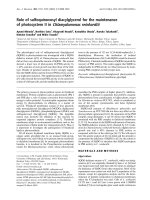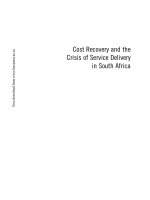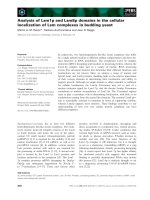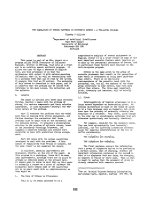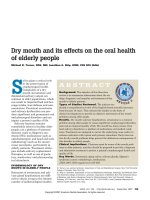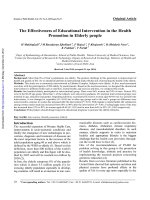The Effectiveness of Educational Intervention in the Health Promotion in Elderly people ppt
Bạn đang xem bản rút gọn của tài liệu. Xem và tải ngay bản đầy đủ của tài liệu tại đây (166.32 KB, 6 trang )
Downloaded from on Monday, December 24, 2012
Iranian J Publ Health, Vol. 39, No.2, 2010, pp.18-23
18
The Effectiveness of Educational Intervention in the Health
Promotion in Elderly people
H Malekafzali
1
,*M Baradaran Eftekhari
2
, F Hejazi
2
, T Khojasteh
2
, R (Heidari) Noot
2
,
K Falahat
2
, T Faridi
3
1
Dept. of Epidemiology & Biostatistics, School of Public Health, Tehran University of Medical Sciences, Iran
2
Center for Development of Research & Technology, Deputy of Research & Technology, Ministry of Health and
Medical Education, Iran
3
Active member of local NGO, Iran
(Received 3 Jan 2010; accepted 21 Apr 2010)
Abstract
Background: More than 8% of Iran’s populations are elderly. The greatest challenge in this generation is improvement of
health and quality of life. So we decided to perform an interventional study with the aim of promoting the health of the elderly.
Methods: This study was a community interventional in Ekbatan Complex. Subjects were elderly. At first, need assessment
was done with the participation of 200 elderly by questionnaire. Based on the need assessment, we designed the educational
interventions in different fields such as nutrition, mental health, and exercise and then, we compared the results.
Results: 0ne hundred elderly participated as interventional group. There were 86% women and 24% of men. Almost 59%
were in the 60-69 age group. More than ¼ of the subjects were university graduates. Pre and post interventional groups were
matched in age, education and gender. Regarding nutrition, second priority food in women aged 60-69 was rice and after the
intervention, it was changed to vegetables (P= 0.05) but in other age groups and in the men’s groups no difference were
noted.Aerobic exercises in women has increased after the intervention (P= 0.01). With regards to mental health, life satisfaction
among women under study has increased from 68% to 90% after the intervention (P= 0.01). Feeling happy most of the time
has increased from 53% to 83% in women aged 60-69 (P= 0.01) and in men from 64% to 83% (P= 0.05) respectively.
Conclusion: Policymakers should design long-term educational programs to promote the elderly lifestyles.
Key words: Intervention, Health promotion, Elderly
Introduction
The successful expansion of Primary Health Care,
improvements in socio-economic conditions and
finally the emergence of new technologies in pre-
vention, diagnosis and treatment of diseases are
the most important factors in the increase of the
adult population aging 60 yr and above which is
defined by the WHO as elderly (1). Based on this
definition, more than 600 million of the world’s
population are elderly and this figure will be dou-
bled by 2025 and will be reached two billion by
2050 (2).
In Iran, the elderly composes 8% of the popula-
tion which is about 5.5 million people (3). In-
creasing elderly population especially in develop-
ing countries will result to an increase in non com-
municable diseases such as cardiovascular dis-
eases, diabetes, Alzheimer, chronic respiratory
diseases, and musculoskeletal disorders. In such
manner, elderly supports in order to maintain
healthy and appropriate lifestyle is the biggest
challenge that the health care providers through-
out the world have to face (2).
One of the recommendations of PAHO for
problem solving in this group is the promotion
of health knowledge, attitude and practice by
implementing the research projects concerning
geriatrics education (4).
Results from a review literature published in the
United State showed that optimum nutrition and
physical exercise have profound effects in the
quality of life in every age more especially in the
*
Corresponding author:
Tel: +98 21 64892607, Fax: +98 21 66582535, E-mail:
Iranian J Publ Health, Vol. 39, No.2, 2010, pp.18-23 Original Article
Downloaded from on Monday, December 24, 2012
H Malekafzali et al: The Effectiveness of Educational…
19
elderly. Therefore, it is necessary to define ways
of promoting health, nutrition and dietary alloca-
tions which has more influence in measuring the
quality of life through research projects (5). In
2004 another research in United State showed the
number of persons aged 75 and above have in-
creased to 23% during 1999-2000 and it may be
due to more tendency to exercise daily, use of ve-
getables and fruits, less tobacco and alcohol and
more
adherence to routine medical examinations (6).
Another study was performed in Taiwan as a
pre-post test aimed to measure the effectiveness
of training programs to improve health elderly.
The course contents include: healthy lifestyle, pre-
vention of diseases, nutrition and appropriate ex-
ercises. Results of the post test showed that edu-
cational programs played an important role in
promoting healthy behavior and awareness (7).
Considering the above, after assessing the needs
of the elderly group we decided to design interven-
tion based on their needs and community mobi-
lization in order to promote the elderly health level.
Materials and Methods
This was an interventional study. After assess-
ing elderly needs, interventional programs were
implemented
based on community mobilization and
its effectiveness were evaluated. Ekbatan Complex
is located in the western part of Tehran, Iran. Ek-
batan characteristics such as high density popu-
lated community with an integrated structure, easy
access to the community and its population, high
homogenous in cultural and social level, having
high per active groups and a humanitarian organi-
zations led us to select it as the venue of our study.
At first, we decided to absorb the participation of
regional stockholders and key persons, and, then,
the executive steps of project were determined
with their participation. Elderly population census
was performed with cooperation of local volun-
teers and a need assessment questionnaire was
designed with the help of all stakeholders, geri-
atrist, and NGO representatives. The question-
naire included; demographic details, physical con-
dition, mental health, recreational activities and
nutrition. Training of the local volunteers on how
to perform the needs assessments and how to
fill up the questionnaires were done by the re-
search team members. After needs assessment,
collected data was analyzed and appropriate edu-
cational interventions to improve health elderly
was designed based on the results.
Volunteers were chosen according to the fol-
lowing criteria: over 40 yr old, having at least high
school diploma and their motivation and interest
in participatory activities. After interviewing candi-
dates, 20 of them (male and female) were selected.
During a four-day training workshop, necessary
instruction booklets were provided and due to
question and answer sessions with various pro-
fessionals, their problems were resolved.
After achieving necessary knowledge and skill
requirement, the volunteers
distributed their knowl-
edge to all the elderly in Ekbatan in different
levels of interventions which include:
1. Home visits and face to face elderly education
2. Referral to physicians- Referral is recom-
mended while the volunteer- during the teaching
sessions- finds out the elderly is experiencing
some health problems which need more medical
attention. Therefore, the volunteer must have done
the necessary arrangements in order to refer the
elderly to Shaheed Ghafari Health Center located
in Ekbatan where a family physician was always
available for any case of referral.
3. Education
through distributing educational pam-
phlets to the elderly: In the initial phase of the
study, educational materials were designed and
prepared in order to support the volunteers. Dur-
ing the initial phase of the home visits, some vol-
unteers encountered with elderly resistance to
enter their homes. Therefore, it was decided that
educational materials should be prepared in a very
simple language that can be easily understood
especially by those with primary education. In
the case that performing face to face educational
session in not possible, this method is the best
suitable alternative. It should be noted that all cases
who attended the study received the pamphlets.
4. Education through arranging a general meet-
ing- question and answer session with the pres-
ence of the experts.
Downloaded from on Monday, December 24, 2012
Iranian J Publ Health, Vol. 39, No.2, 2010, pp.18-23
20
5. Attending exercising session- in addition to
face to face education and distribution pamphlets,
exercises session were performed in different study
meeting
During nine months intervention, every elderly
received at least four home visits. In this period,
volunteers were also monitored through many dif-
ferent ways by the research team members and
finally the effectiveness of the interventions was
measured through a questionnaire. Elderly who
received at least 3 pamphlets (out of 4) were given
the questionnaire. A total of 100 men and women
were selected to fill in the questionnaire.
Sample size
In order to perform the preliminary assessments,
100 elderly men and 100 elderly women were
selected as samples. This sample was enough to
estimate an indicator of quality with a prevalence
of 50%, 95% confidence and 10% accuracy. In
order to evaluate the interventions, all elderly who
have received at least 3 pamphlets and had ap-
propriate cooperation with the research team me-
mbers were selected to answer the questionnaire
(100 males and females).
Ethical Considerations
The study was approved by Tehran University of
Medical Sciences and the National Ethical Com-
mittee of Medical Research. Informed consent was
obtained from all participants and no personal
identifier was recorded on the questionnaires.
Results
Ekbatan complex has an approximately 60
thousand population and 2579 belongs to the
elderly population of which 1227 are women
and 1352 are male. In terms of age grouping,
45.5% are within the 60-69 yr, 38.7% are in the
70-79 age groups and the rest belongs to the 80
or above age group. Table 1 illustrates the socio-
demographic characteristic of elderly in Ekbatan.
The Results of elderly needs assessment are as
follows:
Based on elderly opinions, 92% of women and
70% of men suffer from at least one disease and
involve
its treatments. The prevalence of different
disease such as hypertension, arthritis, diabetes mel-
litus in female is more than male. Psychologically,
70% of elderly people are satisfied with their lives
and in 30% of them, lives are meaningless. Be
worried about the bad event in future observed
in 66/5% of elderly. More than 90% of them have
enough free time which is spent in watching TV
by 97% of them. Almost 67% of these elderly
people do exercises. Related to nutrition, 88%-98%
of elderly use all major food groups, red meat, and
confectionaries are being used by 77% - 82%.
According
to needs assessment, the educational in-
tervention related to mental health, leisure time,
group activity and nutrition were designed (see
method).
Table 1: Sociodemographic characteristic of elderly in
Ekbatan Complex, Tehran, Iran
Characteristic
Female
(n=103)
%
Male
(n=101)
%
Age (yr)
60-69
70-79
=>80
38.9
41.7
19.4
52.5
35.7
11.9
Marital status:
Living with spouse
Single/death of spouse
divorced
45.7
46.6
7.7
94
3
3
Education :
Illiterate
Under diploma
Diploma
higher
20.4
51.4
17.5
10.7
2
22.7
30.7
44.6
Employment status:
With job/salary
No job/salary
55.3
44.7
98
2
Table 2: Frequency of elderly in Ekbatan Complex, Tehran,
Iran according to age before and after the interventions-2006:
Characteristic
Before
intervention
(n=204)
After
intervention
(n=101)
P
Female:
60-69
=>70
35
65
63.6
36.4
0.00
0.00
Male :
60-69
=>70
46
54
50
50
NS
NS
NS=not significant
Downloaded from on Monday, December 24, 2012
H Malekafzali et al: The Effectiveness of Educational…
21
There was a significant difference in terms of age
in
women before and after the interventions (P=
0.00), therefore, in female group, variables under
interventions in the age groups; 60-69 and 70 and
above were compared (Table 2).
Pre and post interventional groups were matched
in age, education and gender.
Mental Health
In this domain, indicators such as; life satisfac-
tion, life is meaningful, does not worry about
the future, and feeling of happiness were as-
sessed before and after the interventions. In the
women’s group, the statistical difference related
to life satisfaction was meaningful. Having a
meaningful life and a feeling of happiness in all
age groups has increased after the interventions
(P= 0.00).
In women aged 70 and older, Not being worried
about the future, had a significant difference
before and after the interventions (P= 0.004).
About 53% of the women aged 60-69 before
the interventions have asserted that, they were
happy most of the time and this percent had in-
creased to 78 after the interventions (P= 0.01).
In the men’s group, "the feeling of happiness"
had a significant difference before and after the
interventions (P= 0.05).
Leisure time
The leisure time in elderly women aged 60-69,
after intervention was less than before (P= 0.01).
Sport activities in elderly women have increased
after the intervention (P= 0.01) and in terms of
the different exercise movements, results showed
that walking, after the interventions have lowered
and aerobics and warming up movements have
increased. Results of Chi-square test showed that
there
is significant difference between the women’s
group before and after the interventions (P= 0.00)
(Table 3).
In the men’s group, spending in leisure time and
performance of exercises, had no significant sta-
tistical
difference before and after the interventions
but in terms of the different types of exercises,
results showed that walking after the interventions
has
decreased and warm-ups and aerobics increased
(P= 0.00).
Table 3: Frequency of the different exercises performed by elderly living in Ekbatan Complex, Tehran, Iran before and
after interventions -2006
Sex /Age Exercise movements Before intervention (%) After intervention (%)
Female:
60-69 yr
- Walking
- aerobics
- swimming and etc.
94.4
5.6
0
46.9
20.4
32.7
=>70 yr - Walking
- aerobics
- swimming and etc
97.2
2.8
0
32.1
35.7
32.1
Male :
=>60 yr
- Walking
- aerobics
- swimming and etc
90.4
0
9.6
45.8
20.8
33.3
Group Activities
In terms of participation in group activities and
being a member of a club, there was significant
statistical difference among elderly women be-
fore and after the interventions in such a way
that before the intervention, 16.7% and after
61.5% of elderly women in group activities
involved (P= 0.00). In elderly men, there wasn't
any significant statistical difference before and
after the intervention.
Nutrition
After intervention, women's group have reduced
consumption of harmful foods such as red meat
and sweets and increased consumption of benefi-
cial foods such as vegetables, but there is no sig-
Downloaded from on Monday, December 24, 2012
Iranian J Publ Health, Vol. 39, No.2, 2010, pp.18-23
22
nificant statistical difference before and after
the interventions. In terms of food preferences,
in the women's group, in all age groups, the
food most preferred before and after the in-
terventions was bread but regarding the second
preference among women aged 60-69, there
was a significant difference before and after the
interventions (P= 0.05) in such away that before
the interventions the second food preference
was rice and after the interventions their prefer-
ence was changed to vegetables. With regards
the third preference which is red meat, there
was no change before and after the interventions.
In the men's group, there isn't any significant
difference in consumption of foods or it's
preference before and after the interventions.
Bread, white meat and dairy products are the
men's food preferences respectively. It is inter-
esting to note that the third food preferences for
the women and the men were completely dif-
ferent, while the women preferred red meat; the
men on the other hand preferred dairy products.
Table 4 shows the summary result of significant
variables on elderly in Ekbatan.
Table 4: Summary of significant variables on elderly men and women aged 60-69 and 70 years and above in Ekbatan
Complex, Tehran, Iran
Variables under study
P-value
Elderly men
P-value
Women (60-69) yr
P-value
Women (70 +) yr
Life satisfaction N.S P=0.01 P=0.00
Having a meaningful life N.S P=0.00 P=0.00
Not worried about the future N.S NS P=0.00
Feeling of happiness P=0.05 P=0.00 P=0.02
Hope for the future N.S P= 0.01 N.S
Spend time in leisure activities N.S P=0.01 N.S
Performance of exercise N.S P=0.00 P=0.03
Different types of exercises P=0.00 P=0.00 P=0.00
Consumption of healthy foods N.S N.S N.S
Avoidance of detrimental foods N.S N.S N.S
First food priority N.S N.S N.S
Second food priority N.S P=0.05 N.S
Third food priority N.S N.S N.S
Participation in group activities N.S P=0.00 P=0.00
Club membership N.S P=0.00 P=0.00
NS= not significant
Discussion
One of the best sources of population informa-
tion to determine its needs and problems are
community (5). Selection of representatives from
the community to assess their needs usually due
to being time consuming is used less (6). In this
method, we used community mobilization and
participation of all stakeholders to design the study,
assess the health needs and implement the inter-
ventional phase. The purpose of this way, is build-
ing the communities capacity to solve their prob-
lem and the main advantage is the community
ownership (8).
The present study had some limitation in the
study design .our participants were unlikely to be
fully representative of these groups in Ekbatan.
Inadequate cooperation of the elderly during in-
terventions reduced sample size of interventional
group and it limits the comparison between before
and after groups. In addition, our study was based
on self-reported information, which could be biased
by the participant` recall.
According to the result of this project, educational
interventions are a suitable method to promote
health elderly regarding to do simple exercise move-
ment and mental health. In women group, due to
Downloaded from on Monday, December 24, 2012
H Malekafzali et al: The Effectiveness of Educational…
23
higher life expectancy, therefore more disability,
lower
educational level and high number of widow,
living alone and financially dependent, it is needed
to pay more attention to this high risk group.
The result of study in Taiwan revealed that the
scores for health promotion knowledge and
positive health behavior in elderly due to educa-
tional intervention were high among subjects who
were aged 60-69 yr, were married ,lived with
family members and had higher education level
(7). It seems that, these factors are important in
educational program and our study confirmed it.
In related to healthy nutrition, unfortunately, in
our study, the educational interventions were not
very effective but in another community-based
intervention study in rural Bangladesh, the re-
sult showed that the educational intervention was
effective to improve of healthy nutrition. This
study concludes that provision of community-
based health education intervention might be a
potential public health initiative to enhance the
health-related quality of life in old age (9).
The result of our study, shows that, mass media
is one of the most important tools for dissemi-
nating educational information related to health
(10) specially in elderly group. Therefore, poli-
cymakers should design long-term educational
programs to promote the elderly lifestyles.
Ethical Consideration
All Ethical issues (such as informed consent, con-
flict of interest, plagiarism, misconduct, co-author-
ship, double submission, etc) have been consid-
ered carefully.
Acknowledgements
The authors wish to thank all the volunteers in
Ekbatan for assistance in data collection and co-
operation. This project was supported by Tehran
University of Medical Science.
References
1. Aspray Tj (1994). Researching the health needs
of elderly people. BMJ, 308: 1655-56.
2. Anonymous (2007). Launches new initiative
to address the health needs of rapidly aging
population. World health organization. Avail-
able, from: www.who.int
3. Amirsadri A, Soleimani H (1384). Phenome-
non of the elderly in Iran and the world.
Health Journal, 1(2): 19-35.
4. Matdas L (2004). Aging in America. Perspec-
tive in Health, 1(9):13-18.
5. Sohng Ky (2002). Health Promoting Behav-
iors of Elderly Korean Immigrants in the
United States. Public Health Nurse, 19(4):
294-300.
6. Chen SW (2004). The Effectiveness of a
Health Promotion Program for the Low- in-
come Elderly in Taipei, Taiwan. Journal of
Community Health, 29(6): 511-25.
7. Huang L, Chen S, Yu Y, Chen P, Lin Y (2002).
The effectiveness of health promotion edu-
cation programs for community elderly. J
Nurs Res, 10(4): 261-70.
8. Mokdad A (2000). Changes in Health Behav-
iors among Older American. Public Health
Reproductive, 119(3):356-61.
9. Rana A, Wahlin A, Lundborg C, Kabir Z (2009).
Impact of health education on health-re-
lated quality of life among elderly persons:
results from a community-based intervention
study in rural Bangladesh. Health Promot
Int, 24(1):36-45.
10. Malekafzali H, Eftekhar H, Baradaran Eftek-
hari M, Paikari N, et al. (2009). Assessing
article related to health in newspapers with
wide circulation in IR.IRAN 2005. Hakim
Journal, 12(3):36-45.


